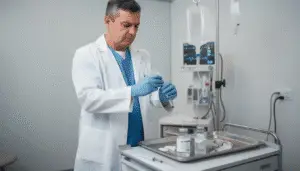Pain Management For CRPS/RSD
Ketamine offers fast-acting relief for CRPS and RSD, blocking pain signals and helping you regain comfort. Long-lasting relief for chronic pain.
Pain Management With PointKetamine

Finding Relief from CRPS/RSD with Ketamine
Chronic pain from CRPS or RSD can feel unbearable, especially when traditional treatments fail to bring relief. At PointInfusion, our ketamine treatments offer a promising solution for those battling these conditions, providing fast-acting, long-lasting relief. If you’ve been living with intense limb pain, burning sensations, or hypersensitivity, ketamine might be the key to reclaiming your life.
Why Use Ketamine for CRPS/RSD?
Ketamine works by interrupting the body’s pain signals, preventing the release of chemicals that trigger the debilitating sensations common with CRPS and RSD. Unlike narcotics, which mask the pain, ketamine addresses the underlying causes of the discomfort. Many patients report significant relief that can last for weeks or even months, making ketamine an effective option for those seeking long-term pain management. If you’ve tried other treatments without success, ketamine might be the game-changer you need.

More Pain Management Services
FAQ's
How does ketamine work for mood disorders?
Ketamine works by affecting the brain’s glutamate system, which plays a key role in mood regulation. It helps restore connections between neurons, allowing your brain to heal and function more effectively. This results in rapid relief from symptoms of depression, anxiety, PTSD, and other mood disorders.
How quickly will I feel better after a ketamine treatment?
Many patients start to feel relief within hours of their first treatment. Ketamine is known for its fast-acting properties, especially when compared to traditional antidepressants, which can take weeks or months to become effective.
Is ketamine safe?
Yes, when administered in a clinical setting under the supervision of a medical professional, ketamine is safe. Our treatments are carefully monitored to ensure the best possible outcomes with minimal side effects.
How many treatments will I need?
The number of treatments varies depending on your condition and individual response. Many patients begin with a series of 6 treatments over 2-3 weeks, followed by maintenance infusions as needed.
Can ketamine help if I haven’t responded to other treatments?
Yes, ketamine is particularly effective for individuals who haven’t had success with traditional therapies like antidepressants or talk therapy. It offers a new path to relief for treatment-resistant mood disorders.
Are there side effects from ketamine treatment?
Some patients experience mild side effects like dizziness, nausea, or dissociation during the infusion. These effects typically wear off within a few hours after treatment and are closely monitored in the clinic.
How long do the benefits of ketamine last?
The effects of ketamine can last anywhere from several weeks to months. Many patients find significant long-term relief, especially when combined with maintenance treatments and other therapeutic approaches.
Can ketamine therapy help with suicidal thoughts?
Yes, ketamine has been shown to rapidly reduce suicidal ideation, often within hours of treatment. It’s one of the fastest-acting therapies for patients in crisis.
Is ketamine addictive?
When administered in a controlled medical environment, ketamine is not addictive. The doses used for mood disorders are much lower than those associated with recreational misuse, and the treatment is closely supervised.
Will I need to stop my current medications before starting ketamine?
In most cases, patients can continue their current medications while receiving ketamine therapy. However, it’s important to discuss your medical history and current medications with your provider to ensure the safest and most effective treatment plan.
Caution: The treatment may not be effective or appropriate for all patients, additional side effects may occur, and all patients should talk to their physician to learn more about the treatment and potential risks.




